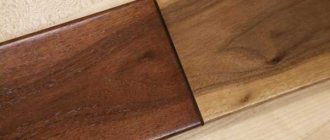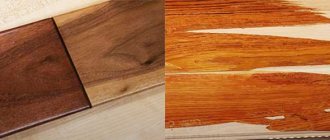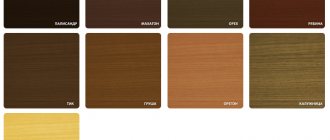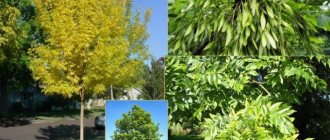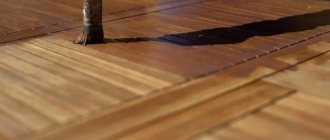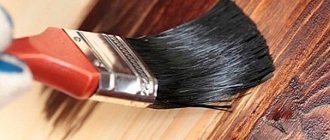Beitz is not just one type of coloring composition. This is a product that breathes life into old furniture, stairs, floors, doors and window sills that have long lost their presentable appearance. From this article you can find out what tinting abilities wood stain has: colors used to create an exotic interior, shades that imitate expensive species, as well as interesting combinations that allow you to achieve beautiful effects.
Stain is a tinting mixture that can be used to give any wood product the desired shade.
Types of stain
Impregnations for wood are divided into types according to the base material for their manufacture.
Water
Water in the base of stain is the most common base ingredient. This is the largest group of impregnations. It is produced in finished form or in powder, which is dissolved in water at home.
Its advantages:
- The solution is non-toxic due to its neutral base;
- A wide range of natural shades from the lightest to the deepest dark will help emphasize naturalness or deepen the tone, make the surface of the product more expressive and noble;
- Easy to apply, low consumption;
- Affordable.
A significant drawback is the ability to lift wood fibers, opening the way for moisture.
The solution is to keep the surface wet for some time, then remove the standing fibers with sandpaper and then impregnate. Another technique to prevent getting wet is to subsequently coat the painted layer with varnish.
In addition, the water base takes a relatively long time to dry.
Alcohol stain
Aniline dye dissolved in denatured alcohol. Wood stain is also sold dry or ready-made.
Its main advantage is that the layer, like alcohol, dries quickly. We classify this quality as a disadvantage: to obtain a uniform color, it is necessary to use a spray gun; when applied manually, alcohol impregnation often forms greasy stains.
Oil stain
Pigments dissolved in oil (White Spirit) allow you to tint wooden surfaces in all possible shades. This product is convenient for use at home - oil stain adheres well, it can be applied with any tool, it evenly penetrates deep into the wood, the texture of the wood is not disturbed, and a protective film is formed.
Acrylic and wax
Wood stain made from wax or acrylic belongs to a new generation of materials for treating and protecting wooden surfaces. Impregnation not only forms an insulating film. The colors of stain are expanded compared to other types - from natural to bright exotic. The effect of a bright colored coating with a natural wood structure is called stain.
This technique is used by many designers of modern furniture - the appearance of the facades of cabinets made of oak or other species with an unusual color evokes unusual sensations. The main disadvantage of the material is that the stain is more expensive than its analogues.
Stain with whitening effect
Not all types of wood need dark saturation; in some cases it is necessary to give a lighter and cleaner shade. For this purpose, stains based on acids or hydrogen peroxide have been developed. With their help, bleached timber is obtained, slightly discolored. In this way, the gray surface can be prepared for subsequent painting and processing.
Decorative properties of oils
When choosing an oil, the visual effect of its application is of paramount importance. From this point of view, oils are divided into conditionally colorless and tinting. Why are oils called colorless only conditionally? Because in any case they change the color of the wood surface, but at the same time maintain transparency. Coloring oils include a colloidal suspension of coloring pigment - from white to soot, which somewhat muffles the contrast of the texture pattern.
Transparent oils always reveal the wood's texture differently. This is due, first of all, to the viscosity index. The lower it is, the smaller the pores of the wood can be impregnated. Thick oils show only the general pattern of the fibers, while rarer oils show fine details of texture. Thus, for treating oak surfaces, the oil should have a viscosity slightly below average, while rich, thick formulations are recommended for alder.
The use of tinting oils is in many ways similar to staining. Tinting wood with oil is quite rarely used as an independent processing technique. Much more often, such compositions are used to emphasize the soft veins between hard wood fibers or to cover individual furniture elements. After drying, tinting oil has less gloss than colorless oil.
It is not known whether such a property of oils as smell can be attributed to decorative qualities. In reality, all oils smell completely different, from haymaking to roasted seeds. After drying, the smell from the oil treatment turns into a very persistent, but subtle aroma, which can become a valuable part of the interior color.
Creating effects
Alcohol or water stain can create an imitation of the naturalness of the coating without obvious traces of processing. When choosing a material for protection and painting, focus on the desired effect: choose a shade of oak, pine or ebony (as in the photo) - the interior will instantly be ennobled.
Products made from ash or oak do not need to be tinted - leave their structure and shade open, choosing the shade of this species that is as close to nature as possible.
Properly stained wood should retain its natural appearance. Only acrylic or wax stains stand out, the color range of which goes beyond naturalness.
The properties of each type of wood are different. In order not to make a mistake when purchasing, pay attention to the flower palette: the composition is applied to planks of different types, where you can see the final result.
What is oil wax and how to make it yourself
Linseed oil with wax is an effective decorative and protective coating that gives wood high moisture-proof properties and increases its wear resistance. Impregnation adds a silky shine to surfaces and emphasizes the natural qualities of wood. Suitable for processing light and dark wood. A completely natural impregnation is optimal for finishing wooden floors, stairs, doors, furniture and other items subject to intense wear.
It is not difficult to prepare linseed oil and wood wax yourself. The easiest way: add grated beeswax to oil heated in a water bath and bring to a homogeneous consistency. The classic proportion by weight is 1:1. The ratio of wax and linseed oil can be varied, creating compositions of varying degrees of viscosity: from thick mastics to liquid impregnations that penetrate deep into the wood structure.
Work technology
Staining a wood surface is not a complicated process, but it requires a responsible approach. In order for the varnish coating to be uniform, the consumption to be minimal, and the stroke to lay evenly, it is necessary to become familiar with the intricacies of the work.
How best to apply stain to a surface: master class
- Spraying is the most effective method. The coating applies evenly, even gray wood will instantly acquire a new shade. The risk of smudges and oil marks is reduced.
- Rubbing the stain over a porous wood product with a rag will help you get the effect of oak or pine even on the most ordinary product made from base raw materials. The composition must be applied carefully, so quick-drying solutions should be avoided.
- A roller or swab for applying stain is useful when covering a small area of wood. In this way, it will be possible to highlight and emphasize the cut pattern, the stain will evenly penetrate deep into the product, creating a protective screen.
- A brush is most often used for work - the tool is easy to use, wood stains apply smoothly in the chosen direction. The master can play with natural patterns and play with existing patterns by saturating colors in certain areas.
The master decides which method is best to use and paint based on his skills, the type of stain and the surface of the wood. To determine which stain in a particular case, when choosing, pay attention to the instructions for the product, which describe the conditions of application and operation.
Basic rules for carrying out work
Often it does not matter how many layers of wood stain will be applied. The main thing is to follow the technique and take into account some nuances:
- The product must be painted strictly according to the wood grain. This way it will be possible to reduce the consumption of solution for smudges and emphasize the design.
- Wood stain should be of a convenient consistency. Non-aqueous is dissolved with white spirit to optimal thickness.
- How many layers to apply is determined by the master depending on the desired shade and effect. Usually 2-3 layers, each of which is thoroughly dried.
Make the first layer thin - the important thing here is to paint it gradually and evenly. The layer will create a base for subsequent applications and reduce the consumption of mortar solution.
- To avoid dark areas, varnish should not be applied to the same area twice.
- When dry, water-based wood stain raises the fibers. They are cleaned with a coarse cloth in a longitudinal or diagonal direction.
- Aqueous and alcohol solutions dry in 2-3 hours, oil solutions dry in 2-3 days.
The rules are the same for interior and exterior work.
Master class on surface tinting
- Clean the wood from dirt and remove protruding fibers with sandpaper;
- Pour the stain, previously diluted according to the instructions, into a small tray. Cooking can be done in small portions.
- Take the tool and, gradually pouring the solution onto it, spread the varnish over the wood.
Do not try to take a lot of paint - this will increase consumption and reduce the quality of the coating.
The most common mistakes
If the wood is not completely dry, it is not recommended to cover it with a thick layer; the stain may peel off over time. If necessary, use a thin layer of stain that absorbs into the wood and does not leave an airtight film on the surface.
- If you are treating wood outdoors, make sure the stain is rated for that purpose and has a UV filter to prevent the wood from blackening or graying.
- Lighter shades have a lower pigment content, which protects the wood from unwanted discoloration, while shades that are too dark accumulate heat better, changing their volume and are more susceptible to cracking.
Controlling air humidity is also suitable for applying thick build stain. If the composition is applied in high humidity, the surface of the stain may become dull soon after application. Therefore, it is recommended to apply stain early in the morning when air humidity is lowest.
Understanding the terms
Tinting wood varnish (as well as stain, impregnation and other means) means gradually adding dye until it acquires the desired shade. That is, color is a dye that is gradually added to the solution.
Note! For each type of wood treatment product, you should use a different type of color. Otherwise, it may simply not dissolve when stirred, resulting in a suspension that cannot be used for processing.
As for which color to choose, it is recommended to adhere to the color chart when purchasing it. It is also useful to know that colors that use organic pigments are not particularly resistant to light. Therefore, for outdoor work it is better to use a color scheme that uses inorganic pigments.
In the photo - a color map for selecting the desired shade
There can be several hundred shades of color; the common types of tinting wooden stairs alone include about 50-100 shades. But if suddenly the color palette is not enough, then you can always mix 2 different colors and get your own shade.
In this case, it is recommended to first experiment with a small amount of color and test the resulting tinted varnish or stain on an unnecessary piece of wood. A sign that everything went well can be considered a smooth surface after drying, the absence of drips and uniform coloring.
First you need to test the tinted varnish or stain on a piece of wood.
Viscosity differences
In carpentry, there are about two dozen common types of wood, differing in density, porosity and vessel sizes. In each individual case, the oil must be selected individually, also taking into account the size, shape and specific features of the product being processed.
Please note that viscosity can only be adjusted with solvents when working with tung oil; other compositions absolutely do not tolerate this
The thicker and more viscous the oil used, the more difficult it is to apply an even layer before polymerization begins. Working with thick oils requires greater care; the resulting drips are subsequently very problematic to remove. The advantages of thick oils are their high drying speed, comparable to some types of varnishes. Also, due to the high content of solid particles, such oils form a more durable film, providing protection from both mechanical damage and contamination.
Thinner oils are used to process products that either have a significant surface area or are full of small parts with many hard-to-reach places. Low viscosity oils can be applied for quite a long time without worrying about uneven drying. However, to obtain high-quality protection, the product must dry for quite a long time; moreover, such oils are usually applied in 3 or more layers.
Protective properties of oils
Unlike most wood preservatives, oil does not form a thick film, maintaining the vapor permeability of the material. At the same time, the hydrophobicity of the surface increases significantly - upon contact with liquid water, the absorption of wood is practically zero. However, a wooden product remains susceptible to shrinkage and swelling; coating with oil does not eliminate these phenomena.
The protective effect of the oil is to compact the outer layers of the tree, thereby preventing the penetration of insect pests into the mass. Due to the absence of paths for moisture penetration, the tree becomes least susceptible to organic damage by mold, mildew or blue staining.
Oil also preserves the color of wood well, which is especially important for exterior decoration of a house. The oil crust that forms on the surface effectively scatters sunlight and limits the flow of oxygen.
Due to this, the rate of cellulose oxidation and the associated appearance of a grayish coating are reduced significantly.
All these properties are more pronounced the thicker the oil used for coating and the more layers are applied. Oils are characterized by the division of protection into two barriers: an internal one, achieved by impregnation of the pores, and an external one, formed when a thin oil film dries on the surface. It should be remembered that oil-impregnated wood has a higher thermal conductivity than dry wood.
Color variety
The most popular are natural shades of stains, which best harmonize with the wood. For furniture finishing, bog oak and walnut are often chosen. Wenge, mocha, and nutmeg will give wood a browner color. The burgundy palette includes mahogany, maple, and cherry.
You can achieve the desired shade by mixing several types of stains. It is important to maintain proportions and use mixtures from only one manufacturer. For larch and pine, both dark and light walnut options are suitable. This paint is classified according to the international standard. Each color has a name and its own code.
When choosing a mixture, a test coloring of the wood is carried out. The resulting shade will be influenced by the natural color and type of material. The quality and density of solutions is of great importance. Compositions with the same numbers from different manufacturers can produce shades of different saturation and depth.
Features of finishing with raw oil and drying oil
When treating wooden products with pure linseed oil, you should be prepared not only for long drying, which can take up to 3 days (for each layer), but also know a number of important features. The raw product is actively absorbed into the structure of the wood, so coating the wood with linseed oil has to be done in 5-7 or more layers. When it dries on the outside, it does not polymerize well on the inside, which is why a seemingly dry product can leave oil stains for a long time. Exposure to ultraviolet light significantly speeds up the drying process. In the sun, treated wood can dry out in 6-8 hours, but the tone of the coating will change: it will become yellowish or even slightly brown.
Drying oil, thanks to its high polymerization rate, has completely different properties: it dries quickly, is not absorbed so actively, and does not change its color. This makes it more practical to use. Regardless of the conditions, the answer to the question of how long drying oil dries is clear - no more than a day (at 20°C). This distinguishes it favorably from raw flaxseed oil. In the future, when talking about this type of finishing, we will mean linseed oil.
Beneficial properties of flaxseed oil
Flax seed is a very popular product in home cosmetology. Flaxseed oil is used for cosmetic purposes to care for the skin of the face and body, maintaining the beauty of hands, nails and hair. This product has a rich chemical composition, which allows it to provide complex beneficial effects on the skin:
- unsaturated fatty acids omega-6 and omega-3 (in terms of their content, flaxseed oil is comparable only to fish oil) help cells regenerate, activate collagen production, promote tissue restoration, and eliminate fine wrinkles;
- niacin (vitamin PP) increases cell tone, eliminates flaking, and prevents the development of skin cancer;
- thiamine (vitamin B1) moisturizes and smoothes the skin, it is indispensable for excessive dry skin;
- choline (vitamin B4) relieves skin irritation and softens it, prevents the appearance of pimples and acne;
- phylloquine (vitamin K) improves complexion and general skin condition;
- folic acid (vitamin B9) relieves inflammation, protects the skin from harmful influences, fights acne and acne.
The benefits of flaxseed oil for skin have been proven for a long time. Regular use of flaxseed oil or flax seed decoctions allows you to solve a number of problems of both cosmetic and medical nature:
- cure skin prone to inflammation and get rid of acne;
- get rid of dryness, redness, peeling or itching of the skin;
- relieve dermatitis, eczema or psoriasis;
- prevent sagging skin, “tighten” the oval of the face;
- smooth out early wrinkles, increase elasticity and tone of the skin;
- reduce the sensitivity of overly delicate skin;
- improve the appearance of flabby, lacking tone or aging skin.
